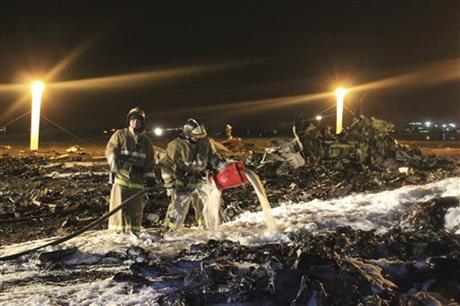
By VLADIMIR ISACHENKOV
In this photo provided by Russian Emergency Situations Ministry, fire fighters and rescuers work at the crash site of a Russian passenger airliner near Kazan, the capital of the Tatarstan republic, about 720 kilometers (450 miles) east of Moscow, Sunday, Nov. 17, 2013. A Russian passenger airliner crashed Sunday night while trying to land at the airport in the city of Kazan, killing all people aboard, officials said. The Boeing 737 belonging to Tatarstan Airlines crashed an hour after taking off from Moscow. There were no immediate indications of the cause. (AP Photo/Russian Emergency Situations Ministry)
Russia Plane Crash
In this photo provided by Russian Emergency Situations Ministry, firefighters and rescuers work at the crash site of a Russian passenger airliner near Kazan, the capital of the Tatarstan republic, about 720 kilometers (450 miles) east of Moscow, on Sunday, Nov. 17, 2013. The Russian passenger airliner crashed Sunday night while trying to land at the airport in the city of Kazan, killing all 50 people onboard, officials said. The Boeing 737 belonging to Tatarstan Airlines crashed an hour after taking off from Moscow. There were no immediate indications of the cause. (AP Photo/Russian Emergency Situations Ministry)
Russia Plane Crash
People place flowers in Kazan airport Monday, Nov. 18, 2013. A plane belonging to Tatarstan Airlines crashed Sunday while trying to land at its home port in the Russian city of Kazan, the capital of the oil-rich province of Tatarstan. The son of the provincial governor and the chief of the local branch of Russia’s main security agency were among the victims. (AP Photo/ Nikolai Alexandrov)
Prev
1 of 3
Next
MOSCOW (AP) — The last word the pilot of the Boeing 737 uttered was “circle.” Moments later the jetliner slammed into the ground, investigators said Wednesday, killing all 50 people on board.
The Moscow-based Interstate Aviation Committee, which investigates plane crashes across the former Soviet Union, concluded a day earlier that the crew failed to land at first attempt, began to stall in a steep climb, then overcompensated — plunging the plane into a near-vertical dive. The report was based on the data retrieved from the plane’s flight parameters recorder, which also showed that its engines and other systems were working fine until the plane hit the ground.
On Wednesday, search teams found a tape of cockpit conversations — a crucial piece of evidence that was missing when its container was found the day before. The recording is expected to shed light upon the motives behind the series of faulty maneuvers that led to the crash.
Vladimir Markin, a spokesman for the Investigative Committee, Russia’s main criminal investigative agency conducting its own probe into the crash, said that recordings of the crew’s conversations with the control tower sounded routine.
The pilot reported that the plane was in a wrong position for the landing and confirmed getting a traffic controller’s command to circle the airport prior to making a second run. “The final word the pilot said before the crash was ‘circle,'” Markin said in a statement.
The Tatarstan Airlines plane was flying from Moscow to the central city of Kazan, 720 kilometers (450 miles) to the east.
Moscow’s Interstate Aviation Committee’s report concluded that to prepare the jet for a second try, the crew switched off autopilot and put the plane’s engines on maximum power, raising the plane’s nose to an angle of about 25 degrees. The abrupt move apparently caused the jetliner to lose speed.
The normal procedure during an aborted landing is to apply near-maximum power and assume about a 5-to-7 degree nose-up attitude, said Kevin Hiatt, a former Delta Air Lines chief pilot and president of the Flight Safety Foundation, a U.S.-based nonprofit.
“Twenty-five degrees nose-up is excessive. There’s no question about that whatsoever,” Hiatt said. “Why they determined they needed to go to that high an angle will be part of the investigation.”
At an altitude of about 700 meters (2,200 feet), the crew then tried to gain speed in order to avert a stall by putting the nose of the plane down. The report said the plane then went into a dive of about 75 degrees and hit the tarmac.
Airplanes can sometimes recover from steep dives but they must be at a sufficiently high altitude.
The committee said it took only 45 seconds from the moment the crew put the engines at maximum throttle until the moment the Boeing smashed into the ground.
Such “loss of control” accidents are responsible for more deaths than any other type of plane crash because they are rarely survivable, according to the Flight Safety Foundation, an industry-supported global aviation safety nonprofit based in Alexandria, Virginia.
The head of Tartarstan Airlines, Aksan Giniyatullin, said Tuesday that the plane’s two pilots had sufficient experience, ranging from 1,900 to 2,500 hours, but admitted that they apparently had no experience with attempting a second landing.



